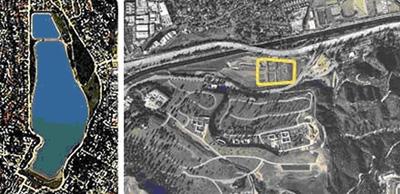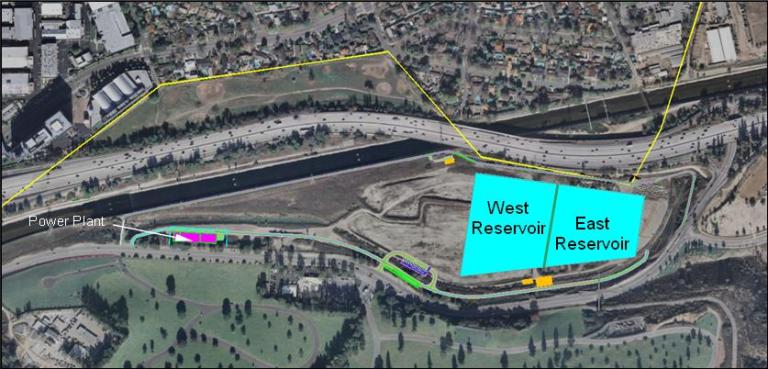
(Left) Silver Lake and Ivanhoe open-air reservoirs will be replaced by Headworks Reservoir
(Right) consisting of two underground storage tanks.
Project Background
Two decades ago, the LADWP recognized the need to begin making changes to its open reservoir system due to emerging State and Federal water quality regulations.
The new underground Headworks Reservoir will replace the Silver Lake and Ivanhoe reservoirs located at the Silver Lake Reservoir Complex, for the purposes of safeguarding and improving drinking water quality.
Compliance With State and Federal Water Quality Regulations
To comply with increasingly more stringent state and federal regulations, the LADWP has been required to make major changes to its open reservoir system. These regulations include the Stage 2 Disinfectants and Disinfection Byproducts Rule and the Long Term 2 Enhanced Surface Water Treatment Rule.
1. Stage 2 Disinfectants and Disinfection Byproduct Rule
Chlorine used to purify water can react with naturally occurring organic material and produce trihalomethanes (THMs). THMs, in significant doses, have been shown to increase the risk of cancer in laboratory animals. With the higher level of algae and other organic materials in the reservoir, the potential to form THMs is greater. The Stage 2 Disinfectants and Disinfection By-Products Rule requires compliance with maximum contaminant levels (MCL) of 80 parts per million (ppm) for Total THM and 60 ppm for haloacetic acids (HAAs). The MCLs must be met at each compliance sample location. Previously, utilities could average all THM and HAA values to obtain one system-wide average.
2. Long Term 2 Enhanced Surface Water Treatment Rule
The Long Term 2 Enhanced Surface Water Treatment Rule addresses covering existing reservoirs and/or providing increased protection from microbial pathogens. Reservoirs in the LADWP system must comply with this regulation which requires the following:
- Cover the reservoir, or
- Achieve 99.99% (4-log) inactivation or removal of viruses
In order to comply with these two regulations, the LADWP must cover or bypass each of its open reservoirs.
Open reservoirs in Los Angeles, including Silver Lake and Ivanhoe, store drinking water from the Los Angeles Aqueduct, the Metropolitan Water District, and groundwater sources. The treated water that enters the open reservoirs is exposed to contamination from surface runoff, birds, insects, animals, and humans. Also, sunlight and elevated temperatures, especially during the summer months, contribute to the growth of algae that degrades water quality and increases taste and odor problems. These problems will be eliminated by covering or bypassing these reservoirs.
Once the Silver Lake and Ivanhoe Reservoirs are bypassed, they will no longer be used as a source of potable water. Rather, they will be maintained as non-potable water bodies for the continued benefit of the community.
Project Scope
In order to meet these two regulations, the LADWP has planned to construct the following facilities at the Headworks Spreading Grounds site:
- Two buried reservoirs with a combined storage capacity of 110-million gallons
- Flow control station
- Headworks Ecosystem Restoration

1. Two Reservoirs
- Buried reservoirs will be 110 million gallons in total capacity, 40 feet in depth, and occupy approximately 15.5 acres.
- Native shrubbery will be planted on top of the buried reservoir.
2. Flow Control Station
- This facility will regulate the flow coming through the new RSC Upper Reach into the reservoirs
- The flow control station will have a capacity of 250 cubic feet per second.
3. Headworks Ecosystem Restoration
- Restoration may include riparian wetlands, open areas with equestrian, cyclist, and pedestrian access.
See additional information on the Project Fact Sheet.
Project Timeline
| Type | Item | Date and / or Range |
| Completed Items | Scoping Meeting | September 2003 |
| Draft EIR | July 2005 | |
| Final EIR | February 2006 | |
| Other City Approvals | March 2006 | |
| LADWP Board Approval | April 2006 | |
| Planning Phase | January 2006 to March 2008 | |
| Design Phase | Headworks East Reservoir | 2008 to 2013 |
| Headworks West Reservoir | 2013 to 2017 | |
| Power Plant / Regulator Station | 2018 to 2019 | |
| Headworks Ecosystem Restoration | 2019 to 2022 | |
| Bid & Award | Contract awarded to Webcor, Obayashi, Lyles, a Joint Venture | December 2011 |
| Construction Phase | Headworks East Reservoir | 2011 to 2015 |
| Headworks West Reservoir | 2015 to 2021 | |
| Power Plant / Regulating Station | 2019 to 2021 | |
| Headworks Ecosystem Restoration | 2022 to 2024 |
Environmental Documentation
Notice of Preparation/Scoping Period
LADWP, in accordance with the California Environmental Quality Act (CEQA), submitted a Notice of Preparation (NOP) for the SLRC Project to the state Clearinghouse on August 22, 2003. The NOP summarizes the SLRC Project and briefly describes the SLRC Project's anticipated environmental impacts. The NOP initiated a public scoping period and invited interested agencies and individuals to provide comments on significant issues they felt should be considered during preparation of a Draft Environmental Impact Report (EIR) for the SLRC Project. On September 17, 2003, the LADWP held a public scoping meeting for the SLRC Project at Friendship Auditorium, which was attended by approximately 150 interested persons. Attendees had an opportunity to review materials prepared for the proposed SLRC Project, ask questions and receive answers, and provide formal scoping comments. The public scoping period ended on September 24, 2003. Comments received during the public scoping period were considered by the LADWP during the preparation of the Draft EIR for the SLRC Project.
Draft EIR
LADWP prepared a Draft EIR that describes the potential environmental impacts associated with the SLRC Project and identifies mitigation measures intended to reduce project impacts. The Draft EIR was released for public review, and a 45-day public review period that ended on September 19, 2005, was established.
Final EIR
LADWP has prepared a Final EIR for the SLRC Project.
Contact Information
Project Manager
Arthur Saginian
(213) 367-1056
[email protected]